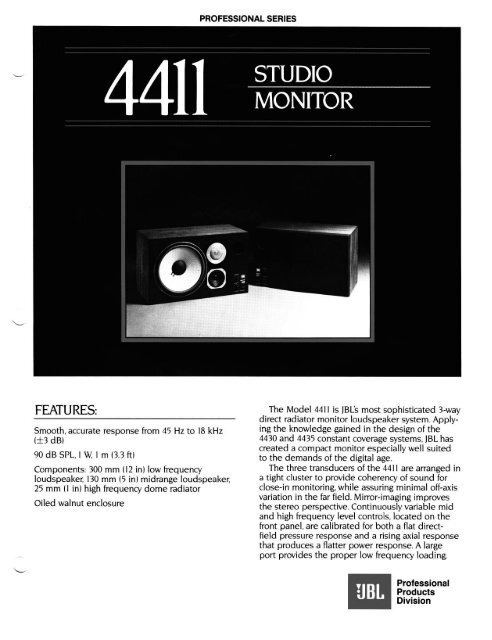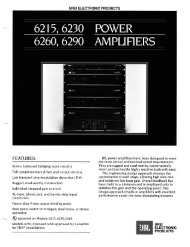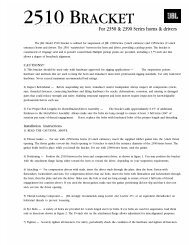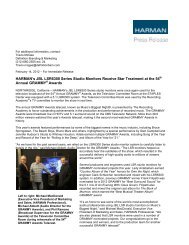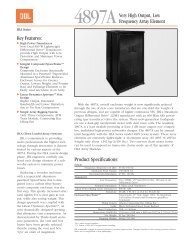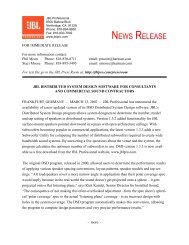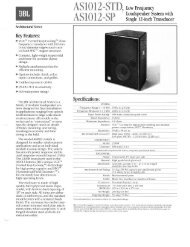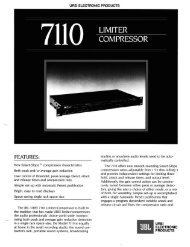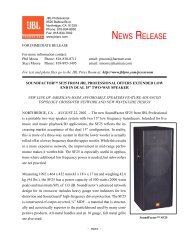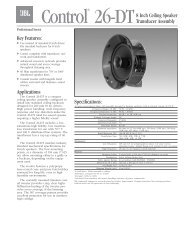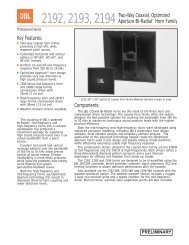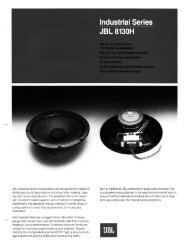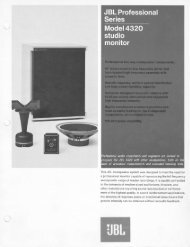4411 - JBL Professional
4411 - JBL Professional
4411 - JBL Professional
Create successful ePaper yourself
Turn your PDF publications into a flip-book with our unique Google optimized e-Paper software.
PROFESSIONAL SERIES<br />
FEATURES: The Model <strong>4411</strong> is <strong>JBL</strong>’s most sophisticated 3-way<br />
direct radiator monitor loudspeaker system. Apply-<br />
Smooth, accurate response from 45 Hz to 18 kHz ing the knowledge gained in the design of the<br />
(+3 dB)<br />
4430 and 4435 constant coverage systems, <strong>JBL</strong> has<br />
created a compact monitor especially well suited<br />
90 dB SPL, I W, 1 m (3.3 ft)<br />
to the demands of the digital age.<br />
Components: 300 mm (12 in) low frequency<br />
The three transducers of the <strong>4411</strong> are arranged in<br />
loudspeaker 130 mm (5 in) midrange loudspeaker, a tight cluster to provide coherency of sound for<br />
25 mm (1 in) high frequency dome radiator<br />
close-in monitoring, while assuring minimal off-axis<br />
variation in the far field. Mirror-imaging improves<br />
Oiled walnut enclosure<br />
the stereo perspective. Continuously variable mid<br />
and high frequency level controls, located on the<br />
front panel, are calibrated for both a flat directfield<br />
pressure response and a rising axial response<br />
that produces a flatter power response. A large<br />
port provides the proper low frequency loading.
With its high volume-velocity air movement capabilities,<br />
the port also maintains the low frequency<br />
dynamic range. The low frequency driver loading is<br />
optimized for flat response when placed away from<br />
room surfaces (approximating a 4 rr environment).<br />
A rising bass characteristic can be chosen by<br />
placing the monitors in proximity to a wall (2 7r<br />
environment). An innovative crossover design<br />
minimizes driver overlap, further assuring flattest<br />
response at a wide variety of angles so that stereo<br />
imaging remains stable over a wide horizontal angle.<br />
Every aspect of the <strong>4411</strong> benefits from <strong>JBL</strong>’s<br />
advanced technology. Each driver is the product of<br />
extensive research and testing, and each has been<br />
designed for optimum performance in the system.<br />
In the tradition of the 4311, the new <strong>JBL</strong> <strong>4411</strong> sets<br />
the standard for today’s compact studio monitors.<br />
HIGH FREQUENCY<br />
DOME RADIATOR<br />
The new recording techniques place a premium<br />
on high frequency accuracy and definition, and <strong>JBL</strong><br />
has designed the 044 high frequency dome radiator<br />
to meet these demands. In developing the 044,<br />
<strong>JBL</strong> engineers used laser interferometry, analyzing<br />
holograms (three-dimensional photographs) of<br />
diaphragm motion to better understand the actual<br />
stresses involved in reproducing musical waveforms.<br />
The diaphragm of the 044 is fabricated from<br />
linen, impregnated with a phenolic resin. <strong>JBL</strong> then<br />
uses a sophisticated vapor-deposition process to<br />
coat the phenolic with a microscopically thin layer<br />
of aluminum. The combination makes the diaphragm<br />
rugged enough to withstand high-energy<br />
high frequency peaks, yet light enough in weight to<br />
respond instantly to transients. The copper voice<br />
coil contributes to the high power handling and<br />
drives the diaphragm over its full circumference for<br />
smoother response. The 044 exhibits outstanding<br />
linearity over its full operating range, at any input<br />
level-there is almost no power compression.<br />
MID FREQUENCY DRIVER<br />
The latest version of a <strong>JBL</strong> design proven in<br />
countless demanding applications, the LE5 midrange<br />
driver has also benefitted from laser interferometry.<br />
The newly designed cone markedly<br />
lowers distortion, and the LE5 produces flat power<br />
response to 6 kHz. Construction features include a<br />
copper voice coil of flat wire, edge-wound to<br />
increase the amount of conductor in the voice coil<br />
gap and improve power handling and transient<br />
response. Because there is more musical energy in<br />
the midrange than at the frequency extremes, <strong>JBL</strong><br />
designed the LE5 with a substantial reserve of<br />
dynamic range.<br />
LOW FREQUENCY DRIVER<br />
The 300 mm (12 in) low frequency driver incorporates<br />
<strong>JBL</strong>’s unique Symmetrical Field Geometry<br />
(SFG) magnetic structure, a design that reduces<br />
second harmonic distortion levels to less than onetenth<br />
of those typical of conventional designs. The<br />
cone is of laminated construction to achieve the<br />
desired combination of rigidity and light weight.<br />
The coating, and exclusive <strong>JBL</strong> formulation, adds a<br />
precise amount of mass and provides the optimum<br />
damping characteristics. The carefully<br />
designed suspension elements, including a newly<br />
engineered spider, reduce DC offsets and eliminate<br />
dynamic instabilities, reducing second harmonic<br />
distortion still furthel:’ The 75 mm (3 in)<br />
diameter voice coil is formed of copper ribbon<br />
wire, hand-wound on edge to place 24% more conducive<br />
material in the voice coil gap. The 19 mm<br />
(3% in) length of the coil allows longer excursions<br />
for greater dynamic range.<br />
FREQUENCY DMDING NETWORK<br />
The sophisticated dividing network of the <strong>4411</strong><br />
has a number of technological refinements that<br />
improve the performance of the system in several<br />
areas. A unique tuned double-bandpass circuit for<br />
the midrange driver provides a steep, symmetrical<br />
crossover to minimize out-of-band colorations and<br />
reduce off-axis response variations. The steeperthan-average<br />
crossover slopes on all three drivers<br />
improve power handling and minimize powercompression<br />
effects.<br />
A major improvement occurs in transient waveform<br />
resolution. <strong>JBL</strong> engineers applied a principle<br />
typically found only in active high frequency electronics:<br />
the use of polypropylene and polystyrene<br />
bypass capacitors, wired in parallel with the network’s<br />
Mylar capacitors to reduce the hysteresis<br />
effects on the signal. The network’s air-core and<br />
iron-core inductors are carefully chosen for their<br />
high current capacity and low DC characteristics.
ADJUSTABLE<br />
RESPONSE CONTOUR<br />
The level controls for the midrange and high<br />
frequency transducers have settings indicating flat<br />
on-axis system response. Most studio engineers<br />
will find these settings ideal. However some engineers<br />
may prefer slightly higher settings of both<br />
controls for a more forward sound, characteristic of<br />
previous monitor designs. These alternate settings<br />
are indicated on both controls. They correspond<br />
approximately to flat power response, that is, uniform<br />
power output over the system’s frequency<br />
range without regard for the variation in the<br />
system’s directivity characteristics.<br />
1. Further technical information may be found in a<br />
paper by M. Gander, “Moving Coil Loudspeaker<br />
Topology as an Indicator of Linear Excursion Capability:’<br />
JoumaJ of the Audio Engineering Society, Vol. 29,<br />
No. l/2, 1981 Jan./Feb.<br />
Frequency Response at IN I meter<br />
Horizontal Off-Axis Response f20°<br />
Horizontal<br />
SPECIFICATIONS:<br />
+40” Horizontal<br />
SYSTEM<br />
Frequency “7;;~; 45 Hz_,* kHz<br />
LOW FREOUENCY<br />
MIDRANGE<br />
Power Capacity’:<br />
150 W<br />
Sensitivity 90 dB SPL, I W, I m (3.3 ftl<br />
Nominal Imcvzdance: 8 fl<br />
Crossover Frequencw<br />
LOUDSPEAKER<br />
I kHz, 4 kHz<br />
Nominal Diameter 300 mm II2 ml<br />
Voice Coil:<br />
76 mm 13 inl copper<br />
Maenetic Assemblv Weight: 4.7 ke 1101/d Ibl<br />
Flux Density<br />
Sensitivity*<br />
LOUDSPEAKER<br />
IO5 tesla ~10,500 gaussl<br />
Nommal Diameter 130 mm 15 inl<br />
89 dB SPL, I W. I mm 13 3 ftl<br />
Voice Cal 22 mm 1% ml edeewound co~oer<br />
Magnetic Assembly Weight: 0.74 kg 11% lb1<br />
Flux Density:<br />
Sensltiwty3<br />
HIGH FREOUENCY DOME RADIATOR<br />
GENERAL<br />
Nommal Diameter 25 mm II ml<br />
1.35 tesla (13.500 gauss1<br />
94 dB SPL, I W. I m I3 3 ftl<br />
Vace Coil 25 mm (I inl coo*er<br />
Magnetic Assembly Weight: 0.9 kg 12 lb1<br />
Flux Density: 1.4 tesla 114,000 gauss1<br />
sensltlvlty’ 89 dB SPL, I W, I m I3 3 ftl<br />
Fmlsh<br />
Oiled walnut<br />
Grille Color: Dark blue<br />
Dimensions<br />
Net Weight:<br />
597 mm x 362 mm x 327 mm deep<br />
(23’fa in x 14% I” x 12% in deeol<br />
24 kg (52 lb)<br />
Shipping Weight 27 kg 159 Ibl<br />
‘Rating based on test signal of filtered random ncuse conformmg to intematlonal<br />
standard IEC 268-5 lpmk nase with I2 dB/octave rolloff below 40 Hz and above<br />
5000 Hz wth a peak-to-average ratlo of 6 dB), hvo hours duration<br />
*Averaged from 100 to 500 Hz, withm I dB<br />
‘Measured<br />
with an input swept from 500 Hz to 2 2 kHz<br />
4Averaged above 5 kHz. within<br />
I dB<br />
Vertical Off-Axis Response: 510” Vertical<br />
+20” Vertical
Beamwidth t-6 dB1 vs Frequency Control Range, High<br />
Directivity vs. Frequency<br />
Control Range, Mid<br />
Delay vs. Frequency<br />
Power Compression<br />
at 85,95, 105 dB<br />
DIstortion vs Frequency IOW DistortIon<br />
Raised 20 dB<br />
Maximum Continuous Sine Wave Input<br />
<strong>JBL</strong> Incorporated. 8500 Balboa Boulevard, PO. Box 2200, Northridge, California 91329 U.S.A.<br />
Oflllharman international<br />
IOM 62204 P711 12/64


